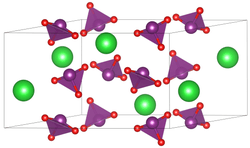Barium iodate
Barium iodate is an inorganic chemical compound with the chemical formula Ba(IO3)2. It is a white, granular substance.
 Unit cell | |
| Identifiers | |
|---|---|
3D model (JSmol) |
|
| ChemSpider | |
| ECHA InfoCard | 100.031.035 |
PubChem CID |
|
| UNII | |
CompTox Dashboard (EPA) |
|
| |
| |
| Properties | |
| Ba(IO3)2 | |
| Molar mass | 487.13 g/mol |
| Melting point | 580 °C (1,076 °F; 853 K)(decomposes) |
| -122.5·10−6 cm3/mol | |
Except where otherwise noted, data are given for materials in their standard state (at 25 °C [77 °F], 100 kPa). | |
| Infobox references | |
Derivation
Barium iodate can be derived either as a product of a reaction of iodine and barium hydroxide or by combining barium chlorate with potassium iodate.[1]
Chemical properties
The compound is stable on a temperature up to approximately 580 °C (1,076 °F). If the temperature is higher than that value, the following reaction, known as Rammelsberg's reaction, occurs:[2]
gollark: Very easy.
gollark: APIONET has something like 5 channels. 3 used ones.
gollark: APIONET is perfect and without flaw.
gollark: This is why it is slightly out of sync.
gollark: Metadata is then shipped using JSON over HTTP/websockets.
References
- Mellor (1973). Melorova moderna neorganska hemija. Belgrade: Naučna knjiga.
- H. Stern, Kurt (2000). High temperature properties and thermal decomposition of inorganic salts. Taylor & Francis. ISBN 0849302560. Retrieved 11-1-2013. Check date values in:
|accessdate=(help)
This article is issued from Wikipedia. The text is licensed under Creative Commons - Attribution - Sharealike. Additional terms may apply for the media files.